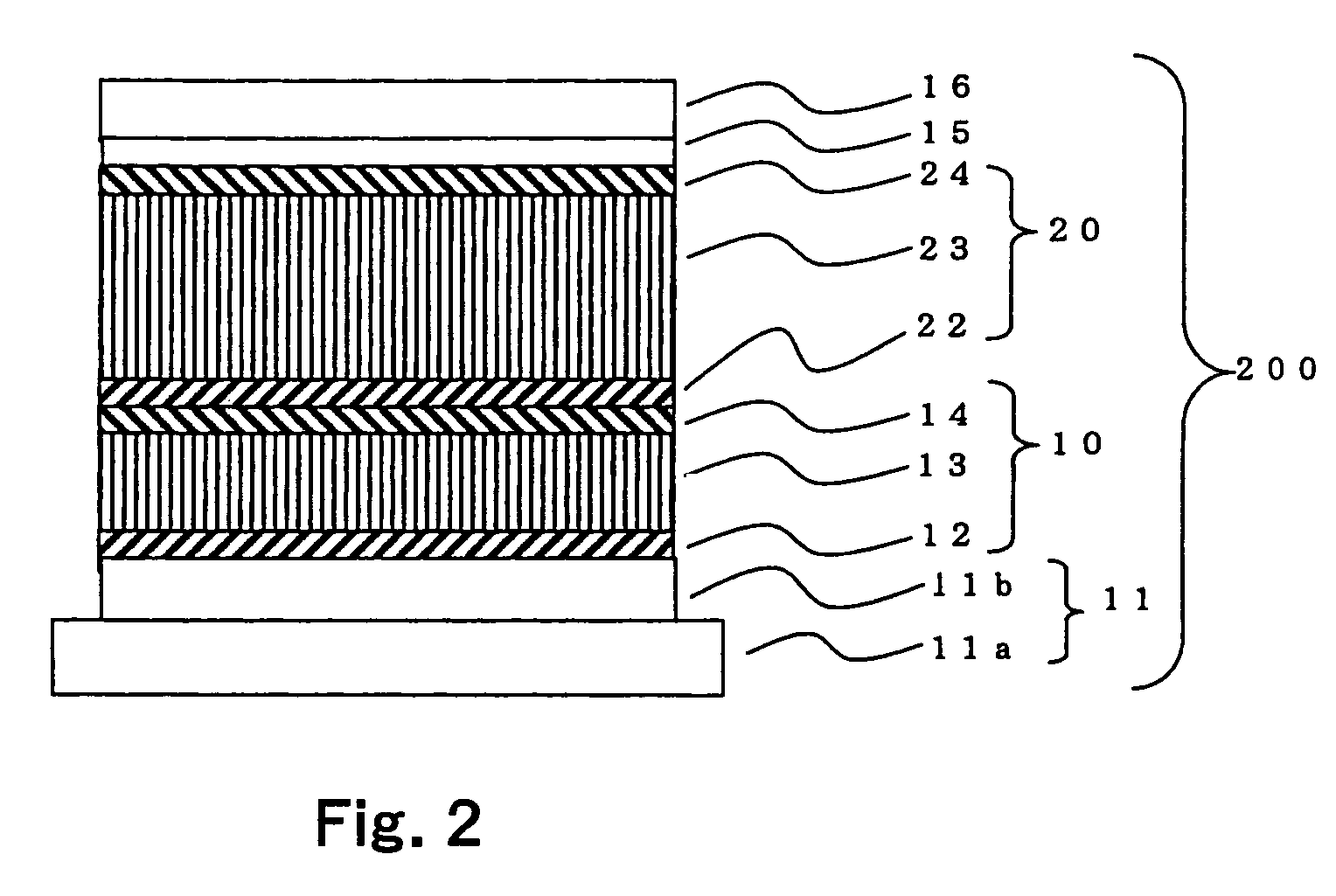Photoelectric conversion device and manufacturing method thereof
a technology of photoelectric conversion and manufacturing method, which is applied in the direction of semiconductor/solid-state device manufacturing, semiconductor devices, electrical devices, etc., can solve the problems of increasing the difficulty of significantly reducing the cost of cell production, large volume of carbon dioxide emissions, and future supply deficiency of fossil fuels, and achieves high photoelectric conversion efficiency
- Summary
- Abstract
- Description
- Claims
- Application Information
AI Technical Summary
Benefits of technology
Problems solved by technology
Method used
Image
Examples
embodiment 1
[0065]As shown in FIG. 1, a photoelectric conversion device 100 of Embodiment 1 has a superstrate type structure and is constituted by laminating, on a substrate 11, a photoelectric conversion layer 10, a transparent conductive layer 15, and an electrode 16, in this order.
[0066]The substrate 11 is produced by depositing, for example, a transparent conductive layer 11b on a light permeable substrate 11a. As the light permeable substrate 11a, a glass plate, a heat-resistant translucent plate of a resin such as polyimide or polyvinyl, or a lamination of those is preferably used. The light permeable substrate 11a is however not particularly restricted, as long as it has high translucency and can structurally support the entire photoelectric conversion device. The light permeable substrate 11a may also be produced by covering the above-mentioned plates with a light permeable metal film, a transparent conductive film, an insulating film, or the like. However, in the case of applying the p...
embodiment 2
[0106]Next, a superstrate laminated type photoelectric conversion device 200 having two photoelectric conversion layers is described as Embodiment 2, a different embodiment from the above, using FIG. 2. It is to be noted that in FIG. 2, the same constituents as those of Embodiment 1 shown in FIG. 1 are provided with the same reference numerals as in FIG. 1.
[0107]This superstrate laminated type photoelectric conversion device 200 is constituted by laminating, on a substrate 11, a first photoelectric conversion layer 10, a second photoelectric conversion layer 20, a transparent conductive layer 15, and an electrode 16, in this order. Among these constituents, the substrate 11, the transparent conductive layer 15 and the electrode 16 can be the same ones as those used for the foregoing superstrate type photoelectric conversion device 100 can be used, and the functions of the respective layers are also the same as those of the superstrate type photoelectric conversion device 100. Hence ...
examples 10 to 14
[0124]In Examples 10 to 14, the superstrate type photoelectric conversion device 100 was manufactured in the following manner under the same conditions as in Examples 1 to 9 except for conditions for forming the p-type semiconductor layer 12.
[0125]The p-type semiconductor layer 12 was formed by forming a first p-type semiconductor layer, containing nitrogen atoms in the same concentration range as that in each of Examples 5 to 8, on the substrate 11 and then depositing a second p-type semiconductor layer, containing no nitrogen, on the first p-type semiconductor layer. In formation of the first p-type semiconductor layer, a gas flow rate ratio ([H2] / [SiH4]) was 150, and other layer formation conditions were shown in Table 1. In formation of the second p-type semiconductor layer, SiH4, H2 and B2H6 were used as raw material gases. A gas flow rate ratio ([H2] / [SiH4]) was 150, and a gas flow rate ratio ([B2H6] / [SiH4]) was shown in Table 1. The thicknesses of the first and second p-type ...
PUM
 Login to View More
Login to View More Abstract
Description
Claims
Application Information
 Login to View More
Login to View More - R&D
- Intellectual Property
- Life Sciences
- Materials
- Tech Scout
- Unparalleled Data Quality
- Higher Quality Content
- 60% Fewer Hallucinations
Browse by: Latest US Patents, China's latest patents, Technical Efficacy Thesaurus, Application Domain, Technology Topic, Popular Technical Reports.
© 2025 PatSnap. All rights reserved.Legal|Privacy policy|Modern Slavery Act Transparency Statement|Sitemap|About US| Contact US: help@patsnap.com



